1. Adaptations are traits that help organisms to survive and/or reproduce
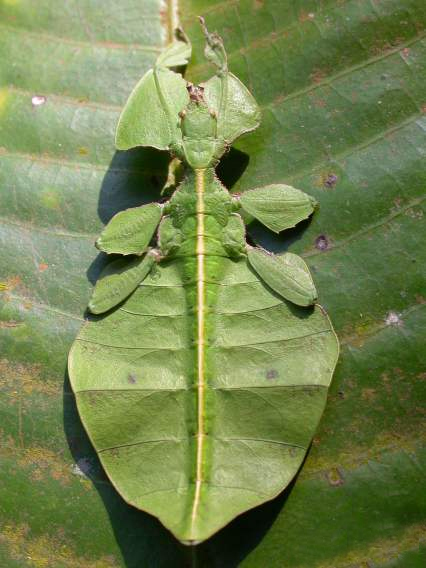
Consider this leaf insect.
It’s part of a family of insects called Phylliidae. All of the species within this family are leaf mimics: they’re camouflaged to look like leaves.
Camouflage is an adaptation. An adaptation is a trait that helps an organism to survive and/or reproduce. Because of their camouflage, leaf Insects are less likely to be noticed and eaten by a predator. In other words, looking like a leaf helps a leaf mimic to survive and pass its genes on.
A related adaptation involves how these insects walk. They rock back and forth, making them look like leaves being blown by the wind.
Among living things, adaptations are everywhere. Here are a few more examples:
- The ability of bats to hunt their insect prey through echolocation: With their extremely high-pitched voices, bats call out into their environment. Then they listen to the echoes that bounce back. Based on the pattern of echoes, a bat can hone in on an insect flying through the air. Dolphins use a similar system to hunt their prey.
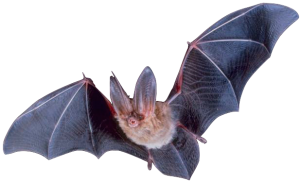
A bat’s ears are an adaptation for hunting prey by echolocation. - The height of a redwood tree. The Coast Redwood (Sequoia sempervirens) can grow up to 100 meters tall (300 feet) to reach the sunlight which powers photosynthesis.
- Snake venom. Most venomous snakes use specialized fangs to inject their venom into their prey. Once injected, the venom causes paralysis and/or massive tissue damage.
- The ability of a kestrel (a small hawk) to see ultraviolet light. Ultraviolet vision allows the kestrel to see the glowing traces of urine left on rocks and soil by mice and other rodents. Based on these traces, kestrels identify areas where they can successfully hunt for their prey.
- The camouflage of the satanic leaf gecko of Madagascar: another leaf mimic.
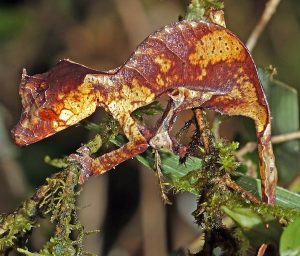
The satanic leaf gecko of Madagascar (click to view a larger image). - The toxic skin of the poison dart frog of central and South America. This toxicity makes these animals extremely unpalatable to predators. To advertise their toxicity, these frogs have evolved a corresponding adaptation: warning coloration. As opposed to camouflaging themselves, they advertise themselves with coloration that signals “Don’t bother eating me: I taste terrible.”
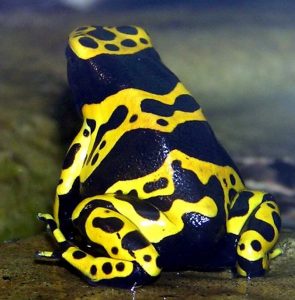
Yellow-banded poison dart frog (Dendrobates leucomelas). Click to view a larger version).
Adaptations are always linked to a specific environmental context. Leaf mimicry, whether it’s in an insect or a gecko, only works as a camouflage adaptation in a leafy forest. In another environment — a treeless desert or a forest where the leaves have fallen off the trees — looking like a leaf becomes a liability. In a non-leafy environment, leaf mimicry would make survival less likely.
Adaptations are the result of a process called natural selection. To see how natural selection works, we’ll start by looking at how humans have been able to create desired traits in domesticated plants and animals.
2. Selective breeding, or artificial selection, parallels how adaptations arise in nature
Let’s start by answering two questions about some organisms that we’re familiar with. All of these questions are going to be related to the idea of a species: a group of organisms that can interbreed with one another to produce fertile offspring.
[qwiz qrecord_id=”sciencemusicvideosMeister1961-Nat_sel, how many species”]
[h]How Many Species?
[q multiple_choice=”true”] How many species are shown below?
[c]ID E=[Qq]
[f]IFRoYXQmIzgyMTc7cyBjb3JyZWN0LiBBbGwgb2YgdGhlc2UgcGxhbnRzIGFyZSB2YXJpZXRpZXMgb2YgdGhlIHNhbWUgc3BlY2llcywgQnJhc3NpY2Egb2xlcmFjZWEswqA=b3Igd2lsZCBjYWJiYWdlLiBUaGUgd2lsZCBmb3JtIGxvb2tzIGxpa2UgdGhpczo=
Cg==[c]IDQ=[Qq]
[f]IE5vLiBBbGwgb2YgdGhlc2UgcGxhbnRzIGFyZSB2YXJpZXRpZXMgb2YgdGhlIHNhbWUgc3BlY2llcywgQnJhc3NpY2Egb2xlcmFjZWEswqA=b3Igd2lsZCBjYWJiYWdlLiBUaGUgd2lsZCBmb3JtIGxvb2tzIGxpa2UgdGhpczo=
Cg==[q multiple_choice=”true”] How many species are shown below?
[c]ID E=[Qq]
[f]IFRoYXQmIzgyMTc7cyBjb3JyZWN0LiBBbGwgb2YgdGhlc2UgZG9ncyBhcmUgdmFyaWV0aWVzIG9mIHRoZSBzYW1lIHNwZWNpZXMsIA==Q2FuaXMgbHVwdXMsIA==b3Igd29sdmVzLiBUaGUgd2lsZCBmb3JtIGxvb2tzIGxpa2UgdGhpczo=
Cg==[c]IDM=[Qq]
[f]IE5vLiBBbGwgb2YgdGhlc2UgZG9ncyBhcmUgdmFyaWV0aWVzIG9mIHRoZSBzYW1lIHNwZWNpZXMsIA==Q2FuaXMgbHVwdXMsIA==b3Igd29sdmVzLiBUaGUgd2lsZCBmb3JtIGxvb2tzIGxpa2UgdGhpczo=
Cg==[/qwiz]
What you saw above are both consequences of selective breeding. In selective breeding, animal or plant breeders envision a desired trait in an animal or a plant. For many generations, breeders select organisms with that desired trait, allowing only those with the desired trait to reproduce. The breeders, in other words, create and maintain a carefully guarded gene pool that only includes organisms with genes for the desired trait.
In the case of plants, breeders select seeds from those plants with the desired trait and use those seeds for the next crop. The many varieties of wild cabbage, Brassica oleracea, are an example.
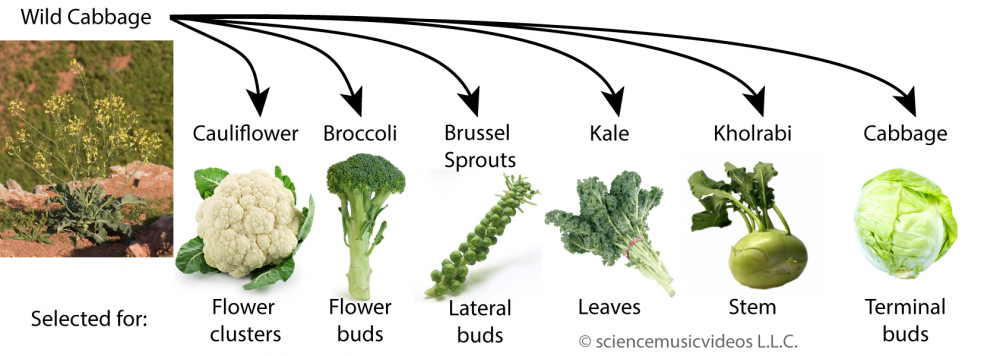
- Selection for a thick stem led to kohlrabi.
- Selection for leaves led to kale.
- Selection for flower buds and stems led to broccoli.
- Brussel sprouts were bred for larger lateral leaf buds
- Cabbage was bred for larger terminal leaf buds
- Cauliflower was bred for the clusters at the base of the flower.

Almost all of the plants we eat came to have their current form through selective breeding or artificial selection. To focus on just one, maize or corn was first domesticated about 10,000 years ago by people living in Mexico. To domesticate means to take a wild species and breed it so that it becomes suited to human purposes.
The wild ancestor of maize is a plant called teosinte. Teosinte is a wild grass, highly branched, with small seeds and cobs. The ancient Mexicans who bred teosinte into its modern form selected two traits: 1) larger seeds and 2) cobs with a higher number of seeds. Repeating this process for many generations led to the emergence of what is now one of the most important staple crops on Earth.
In the case of animals, breeders select males and females with the desired traits and breed them together. By continuing to select for the same trait for many generations, breeders have produced distinct varieties of dogs, cows, sheep, cats, etc.
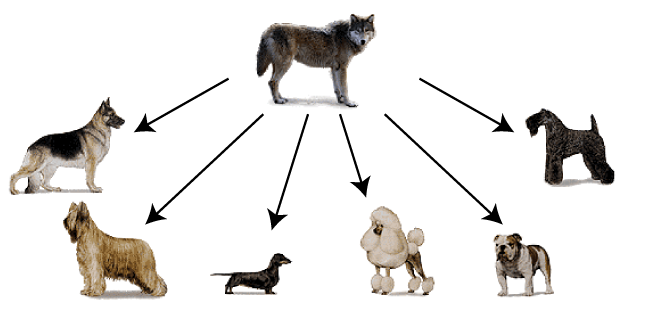
Note that the differences between dog breeds aren’t only about looks. It’s also about behavior. Breeds like Rottweilers and boxers were bred to be protective. Collies and sheepdogs were bred for herding. Retrievers retrieve. Spaniels are hunting dogs. These behaviors are innate (though training can improve and shape a dog’s behavior). Click here to read more about the genetic basis of dog behavior (the link opens in a new tab).
Selective breeding has produced hundreds of varieties of animals or plants with desired traits. A term for “trait” used in biology is phenotype, which means any observable characteristic. So, another way to formulate what happens in selective breeding is that breeders create distinct phenotypes in controlled populations of organisms.
To contrast the process of selective breeding to what happens in nature, selective breeding is also called artificial selection. Before we examine what happens in nature — the adaptation-producing process of natural selection — complete the quiz below.
3. Adaptation and Selective Breeding: Checking Understanding
[qwiz qrecord_id=”sciencemusicvideosMeister1961-Nat_sel, adaptation, selective breeding”]
[h]Adaptation and Selective Breeding
[i]Biohaiku
Selective breeding:
Humans choose traits they desire
Wolves became poodles
[q] A trait that can help an organism survive and/or reproduce is called a(n) [hangman]
[c]IGFkYXB0YXRpb24=[Qq]
[q] In the case of the leaf insect, the adaptation is for [hangman].
[c]IGNhbW91ZmxhZ2U=[Qq]
[q] For a trait to be adaptive, it must help an organism to [hangman] or reproduce.
[c]IHN1cnZpdmU=[Qq]
[q] A leaf insect’s camouflage is only useful in a forest with many leaves. This is an example of the idea that the value of an adaptation is usually limited to a specific [hangman].
[c]IGVudmlyb25tZW50[Qq]
[q multiple_choice=”true”] The moon’s mass and distance from the Earth are an adaptation for producing the ocean’s tides.
[c]IHRydWU=[Qq]
[f]IE5vLiBUaGUgbW9vbiBpcyBhIG5vbmxpdmluZyBvYmplY3QuIFdoaWxlIGl0cyBkaXN0YW5jZSBhbmQgbWFzcyBhcmUgbGFyZ2VseSByZXNwb25zaWJsZSBmb3IgdGhlIG9jZWFuJiM4MjE3O3MgdGlkZXMgKHRoZSBzdW4gYWxzbyBwbGF5cyBhIHJvbGUpLCB0aG9zZSBhcmVuJiM4MjE3O3QgYWRhcHRhdGlvbnMuIFRoZXkmIzgyMTc7cmUgc2ltcGx5IHBoeXNpY2FsIGF0dHJpYnV0ZXMu[Qq]
[c]IGZh bHNl[Qq]
[f]IFRoYXQmIzgyMTc7cyBjb3JyZWN0LiBUaGUgbW9vbiBpcyBhbiBpbmFuaW1hdGUgb2JqZWN0LiBJdCBoYXMgY2hhcmFjdGVyaXN0aWNzLCBidXQgbm9uZSBvZiB0aGVtIGFyZSBhZGFwdGF0aW9ucyAod2hpY2ggYXJlIGxpbWl0ZWQgdG8gbGl2aW5nIHRoaW5ncyku[Qq]
[q]In domesticated plants and animals, humans produce desired traits through the process of [hangman] breeding
[c]c2VsZWN0aXZl[Qq]
[q]For selective breeding to work, a breeder must select (or breed for) the same trait for multiple [hangman]
[c]Z2VuZXJhdGlvbnM=[Qq]
[q]Terriers, poodles, labrador retrievers, and chihuahuas are all members of the same [hangman]. Their differences were brought about through [hangman] breeding, also known as [hangman] selection.
[c]c3BlY2llcw==[Qq]
[c]c2VsZWN0aXZl[Qq]
[c]YXJ0aWZpY2lhbA==[Qq]
[q]In animals like dogs, breeders have been able to create breeds with specific body forms and specific [hangman], such as protecting, retrieving, herding,
[c]YmVoYXZpb3Jz[Qq]
[q]A word used in genetics for a physical or behavioral trait or characteristic is [hangman].
[c]cGhlbm90eXBl[Qq]
[/qwiz]
4. Natural Selection: An interactive reading
Natural selection is how adaptations arise in nature. The idea of natural selection was developed in the mid-1800s by two British naturalists: Charles Darwin and Alfred Russel Wallace. Darwin wrote up his ideas in a book entitled On The Origin of Species, which was published in 1859.
Natural selection is a way of explaining evolutionary change. Focusing on the leaf insect, the basic idea is that many generations ago, the ancestors of leaf insects didn’t look like their descendants today. The adaptation — the camouflaged form of the leaf insect — had to evolve over time. How can a population without an adaptation evolve into a population with an adaptation?
Natural selection involves four interrelated ideas, some of which are facts about nature, and some of which are consequences of these facts. Let’s see them at work.
[qwiz qrecord_id=”sciencemusicvideosMeister1961-Nat_sel, interactive reading”]
[h]Interactive reading: natural selection
[i]
[q] Natural selection begins with the idea of inherited variation. In any population of any species, individuals are not identical. Just go for a walk in the community that you live in, and look at your fellow human beings. On any dimension you can imagine, individuals have differences.
In the case of a leaf insect, the ancestor may have been a much more generalized type of insect. And within that ancestral population, some were perhaps darker in color, while others were greener. Some were flatter, and others longer. Some had fatter legs, and others had skinnier legs. This continues to this day. You might not notice it unless you look carefully, but in any particular species you meet, whether they’re ants, orchids, bees, dogs, mushrooms, E. coli bacteria, mice, robins, or raccoons, there is individual variation.
[q labels = “top”]Variations can come about in different ways. If you have two seeds from the same species of plant and put one in fertile soil and one in rich soil, or provide one with ample water but provide the other with less water, the resulting plants will vary in size, mass, etc. That kind of variation is influenced by _________________ differences. What matters for natural selection is the kind of variation that’s controlled (or influenced) by genes: inherited variation. These types of variations are a result of inherited ___________ differences between the members of a population.
In other words, since we’re talking about change in a population’s traits over time, the key thing that matters is ____________ differences, since these are the only differences that get ____________ from one generation to the _______ one. The key point is that the process of natural selection works on variation that’s related to heredity, not variation that’s caused by _________________ factors.
[l]next
[fx] No. Please try again.
[f*] Correct!
[l]environmental
[fx] No, that’s not correct. Please try again.
[f*] Great!
[l]genetic
[fx] No, that’s not correct. Please try again.
[f*] Excellent!
[l]passed on
[fx] No. Please try again.
[f*] Correct!
[q] To summarize, the first idea is that all populations have [hangman]. The type that matters in terms of natural selection is caused by [hangman] (or genes) and not by the [hangman]
[c]IHZhcmlhdGlvbg==[Qq]
[c]aGVyZWRpdHk=[Qq]
[c]ZW52aXJvbm1lbnQ=[Qq]
[q]The second idea is overproduction of offspring: All species produce young at a rate that far exceeds the actual growth rate of that species. Here are some examples:
- Bacterial cells might reproduce themselves every 20 minutes.
- A pair of nesting robins can reproduce three times each year, and lay 3 – 5 eggs each time.
- A dandelion flower produces hundreds of winged seeds.
- A nesting female sea turtle can lay up to 100 eggs every breeding season.
Even slow breeders like elephants or grizzly bears, will, throughout their long lives, produce more offspring than will survive to become adults.
[q]Why do so few offspring survive? Ultimately, it comes down to limited resources. In a finite world, there’s not going to be enough of whatever resource is needed by the offspring of any species for all of them to survive. For an animal, that limiting resource might be access to food. For a plant, that might be access to suitable soil and sunlight.
The result will be competition for these limited resources. Simply stated, the rule in nature is that many offspring are [hangman], but few will [hangman] to become reproducing adults.
[c]Ym9ybg==[Qq]
[c]c3Vydml2ZQ==[Qq]
[q multiple_choice=”true”] Overproduction applies to leaf insects, too. Guess how many eggs a typical female leaf insect lays?
[c]IDEw[Qq]
[f]IE5vLiBZb3UmIzgyMTc7cmUgb2ZmIGJ5IGEgZmFjdG9yIG9mIGF0IGxlYXN0IDEwLg==[Qq]
[c]IDUw[Qq]
[f]IE5vLiBZb3UmIzgyMTc7cmUgb24gdGhlIHJpZ2h0IHRyYWNrLCBidXQgdGhlIG51bWJlciBpcyBoaWdoZXIgc3RpbGwu[Qq]
[c]IG92ZX IgMTAw[Qq]
[f]IEV4Y2VsbGVudC4gVGhlIG51bWJlciB2YXJpZXMgYSBsb3QgYW1vbmcgbGVhZiBpbnNlY3RzLCBidXQgZmVtYWxlcyB0eXBpY2FsbHkgbGF5IGJldHdlZW4gMTAwIGFuZCAxMjAwIGVnZ3Mu[Qq]
[q]Let’s summarize.
- In any population, there’s a significant amount of [hangman] variation.
- In any population, the number of offspring born is much [hangman] than the number of adults who will survive to adulthood and successfully [hangman].
[c]aGVyZWRpdGFyeQ==[Qq]
[c]Z3JlYXRlcg==[Qq]
[c]cmVwcm9kdWNl[Qq]
[q]The third idea is that competition for limited resources leads to differential survival. If many are born, but few survive, what determines who survives? Some survival will be about luck or good fortune. But any offspring’s chance of surviving to adulthood is also influenced by its genetic inheritance and its resulting phenotype. Any individual with an inherited genetic variation that results in a phenotype that gives it a survival advantage will have a higher chance of surviving the perils of infancy and youth and making it to adulthood.
[q labels = “top”]In the case of our leaf insect, any young insect that has a form or color that makes it ever so slightly less ____________ to its predators is going to have a higher chance of ____________. Note that his difference doesn’t have to be an all-or-nothing thing. If you have two individuals, one of which is only a tiny bit more camouflaged than the other, then the one with ___________ camouflage is going to have a _________ chance of surviving.
The difference might only show up for part of the day (at dusk or dawn, for example). But if that difference is determined by __________, then the genes for superior camouflage will be passed on to the next ________________. By contrast, the genes for poor camouflage will be eaten (literally) by _____________. Slowly but surely, predators will __________ those genes for poor camouflage from the population. What will be left will be genes that produce the well-camouflaged _______________.
[l]better
[fx] No. Please try again.
[f*] Correct!
[l]heredity
[fx] No. Please try again.
[f*] Good!
[l]generation
[fx] No, that’s not correct. Please try again.
[f*] Correct!
[l]higher
[fx] No, that’s not correct. Please try again.
[f*] Good!
[l]predators
[fx] No. Please try again.
[f*] Excellent!
[l]remove
[fx] No, that’s not correct. Please try again.
[f*] Correct!
[l]surviving
[fx] No. Please try again.
[f*] Good!
[l]visible
[fx] No. Please try again.
[f*] Great!
[l]phenotype
[fx] No. Please try again.
[f*] Excellent!
[q]Differential survival is what generates adaptation.
Compare this case of natural selection to what happens during artificial selection. if you were a shepherd breeding sheep for superior wool, you’d select those sheep in your herd with the best wool, and have them breed with one another to create the next generation. You’d prevent sheep with poor quality wool from breeding, and the most likely way you’d do that would be to kill those sheep…and eat them (or sell the meat to others). You’re (literally) consuming the genes for poor quality wool while selecting for reproduction those sheep with superior wool. The effect is to reduce the frequency of the genes you don’t want (the ones for poor-quality wool) while increasing the frequency of the genes that produce the phenotype you want (high-quality wool).
In the case of the leaf insect, it’s as if the predators were the breeders. By trying to find and eat leaf insects, the leaf insect’s predators inadvertently work to create better and better-camouflaged leaf insects.
[l]adaptation
[fx] No. Please try again.
[f*] Correct!
[l]camouflage
[fx] No, that’s not correct. Please try again.
[f*] Great!
[l]find
[fx] No, that’s not correct. Please try again.
[f*] Great!
[l]predators
[fx] No, that’s not correct. Please try again.
[f*] Good!
[l]selected
[fx] No. Please try again.
[f*] Excellent!
[l]speed
[fx] No. Please try again.
[f*] Excellent!
[l]survive
[fx] No. Please try again.
[f*] Excellent!
[q]Let’s review the key parts of natural selection that we’ve covered thus far.
- In every population, there’s [hangman]. The type that matters for natural selection is caused by [hangman].
- In every species, parents produce [hangman] at a rate that exceeds that environment’s ability to support them. In other words, many are [hangman], but few [hangman].
- Overproduction of offspring leads to [hangman] survival.
- The ones who survive will most often be those with [hangman] traits.
[c]dmFyaWF0aW9u[Qq]
[c]aGVyZWRpdHk=[Qq]
[c]b2Zmc3ByaW5n[Qq]
[c]Ym9ybg==[Qq]
[c]c3Vydml2ZQ==[Qq]
[c]ZGlmZmVyZW50aWFs[Qq]
[c]YmVuZWZpY2lhbA==[Qq]
[q]Because a key factor determining survival is the activity of other organisms, then selection for beneficial traits can unleash an evolutionary [hangman] race. In this situation, an [hangman] in one population of organisms forces a counter adaptation in another population, and that feeds back to the first population.
It’s called an arms race because it’s similar to what happens between rival nations. As each one builds a bigger army, the rival is forced to counter by expanding its army. Starting after World War II and ending in the 1980s, an arms race between the United States and the former Soviet Union led to a situation where each nation had tens of thousands of nuclear bombs aimed at the other. That number of bombs could destroy each nation (and many other nations) many times over.
[c]YXJtcw==[Qq]
[c]YWRhcHRhdGlvbg==[Qq]
[q labels = “top”]The last idea is that repetition of selection in the same direction leads to adaptation. Selection, in other words, has to be _____________, repeated in generation after generation in the same _____________. This can occur when two species are locked in the type of evolutionary _________ race described above. And it can also occur among the members of a single species. In a population of trees, each member of the species is ____________ against its neighbors for access to light. Any inherited _______________ that allows for phenotypes like stronger wood, more efficient production of wood, seeds that are a bit better at sprouting, or seedlings that grow faster than others will be selected for, and the frequency of genes for those beneficial phenotypes will __________ within that population.
Leaf insects didn’t develop their ______________ in a single generation. It took many thousands of generations of selection in the same ____________ to generate this kind of ______________.
[l]adaptation
[fx] No, that’s not correct. Please try again.
[f*] Good!
[l]arms
[fx] No. Please try again.
[f*] Good!
[l]camouflage
[fx] No. Please try again.
[f*] Excellent!
[l]competing
[fx] No. Please try again.
[f*] Great!
[l]cumulative
[fx] No. Please try again.
[f*] Excellent!
[l]direction
[fx] No, that’s not correct. Please try again.
[f*] Correct!
[l]increase
[fx] No. Please try again.
[f*] Good!
[l]variation
[fx] No. Please try again.
[f*] Good!
[q]Along with selection, there needs to be renewed creation of variation. This renewal of variation is caused by ongoing mutation of the genes within a population. These mutations are random and provide the raw material upon which natural selection can act upon in each generation. Note also that populations aren’t mutating so that they can adapt. There’s no foresight to evolution, no planning. It’s just random generation of variation, followed by selection, repeating over time.
[q]Variation within a population is renewed by continued [hangman] with a population’s genes.
[c]bXV0YXRpb24=[Qq]
[q]Adaptations like the camouflage of the leaf insect only come about if selection repeats in the same [hangman] for many generations.
[c]ZGlyZWN0aW9u[Qq]
[/qwiz]
5. A few additional ideas related to natural selection
1. What Evolves, and What’s Selected?
Natural selection acts upon individuals. However, individuals don’t evolve. An individual leaf insect will either live to maturity and reproduce or be eaten by a predator (or suffer some other fate that keeps it from living to maturity). Individuals are selected. Populations evolve.
We can even be more specific. What changes in a population are the frequencies of specific phenotypes, along with the frequencies of the underlying genes that code for these phenotypes. Because of natural selection, phenotypes that confer a survival advantage increase in frequency, while those that are harmful decrease in frequency.
2. What is fitness?
Natural selection is often summarized as survival of the fittest. What is fitness, in an evolutionary sense? It’s simply reproductive success. The fittest individuals are those with phenotypes that enable them to survive, reproduce, and leave the most offspring.
Because environments can change, the criteria for fitness also can shift. A phenotype that confers a survival advantage in one generation can become a disadvantage if the environment shifts. Biologists describe these criteria for fitness as selective pressure. This pressure can be from other organisms (competition, predation, parasitism, etc.) or it can be from the non-living environment (temperature, nutrient availability in the soil, intensity of sunlight, amount of rainfall, etc.). But these forces “press down” upon populations, removing those individuals with disadvantageous phenotypes, and allowing those with beneficial phenotypes to survive and reproduce.
Here’s how Darwin described this in the Origin of Species (from Darwin Online)
Never forget that every single organic being around us may be said to be striving to the utmost to increase in numbers; that each lives by a struggle at some period of its life; that heavy destruction inevitably falls either on the young or old, during each generation or at recurrent intervals. Lighten any check, mitigate the destruction ever so little, and the number of the species will almost instantaneously increase to any amount. The face of Nature may be compared to a yielding surface, with ten thousand sharp wedges packed close together and driven inwards by incessant blows, sometimes one wedge being struck, and then another with greater force.
In the other tutorials in this series on evolution, we’ll look at some case studies of natural selection. But first, use this quiz to consolidate your understanding.
6. Adaptation, Artificial Selection, and Natural Selection: Checking Understanding
[qwiz qrecord_id=”sciencemusicvideosMeister1961-Nat_sel, checking understanding”]
[h] Adaptation, Artificial Selection, and Natural Selection
[i]Biohaiku
Selective pressure
Wedges pound down; many die
The fittest survive
[q] An [hangman] is a trait that helps organisms to survive or reproduce.
[c]IGFkYXB0YXRpb24=[Qq]
[f]IENvcnJlY3Qh[Qq]
[q] Adaptations are always linked to a specific [hangman].
[c]IGVudmlyb25tZW50[Qq]
[f]IEdyZWF0IQ==[Qq]
[q] Kale, broccoli, and cauliflower are all [hangman]that were bred from the wild cabbage, Brassica oleracea.
[c]IHZhcmlldGllcw==[Qq]
[f]IEdyZWF0IQ==[Qq]
[q] In selective breeding, breeders create a carefully guarded gene [hangman] that only includes organisms with a desired [hangman]
[c]IHBvb2w=[Qq]
[f]IEdyZWF0IQ==[Qq]
[c]IHBoZW5vdHlwZQ==[Qq]
[f]IEV4Y2VsbGVudCE=[Qq]
[q] During the creation of any particular dog breed, breeders selected males and females with [hangman] phenotypes, and bred them together. The breed emerged after breeders repeated this process for many [hangman]
[c]IGRlc2lyZWQ=[Qq]
[f]IEdyZWF0IQ==[Qq]
[c]IGdlbmVyYXRpb25z[Qq]
[f]IEdyZWF0IQ==[Qq]
[q] In animal breeding, the desired phenotype can be a particular body form, but it also might be a specific [hangman].
[c]IGJlaGF2aW9y[Qq]
[f]IEdyZWF0IQ==[Qq]
[q] The co-discoverers of the process of natural selection were Charles [hangman] and Alfred Russel [hangman].
[c]IERhcndpbg==[Qq]
[f]IEdyZWF0IQ==[Qq]
[c]IFdhbGxhY2U=[Qq]
[f]IEdvb2Qh[Qq]
[q multiple_choice=”true”] Adaptations arise through
[c]IGFydGlmaWNpYWwgc2VsZWN0aW9u[Qq]
[f]IE5vLiBBcnRpZmljaWFsIHNlbGVjdGlvbiBpcyBob3cgaHVtYW5zIGJyaW5nIGFib3V0IGRlc2lyZWQgdHJhaXRzIGluIGRvbWVzdGljYXRlZCBwbGFudCBvciBhbmltYWwgc3BlY2llcy4gSGVyZSYjODIxNztzIGEgaGludDogYWRhcHRhdGlvbnMgY29tZSBhYm91dCB3aXRob3V0IGh1bWFuIGRlc2lnbi4gV2hhdCBwcm9jZXNzIGNvdWxkIGJyaW5nIHRoYXQgYWJvdXQ/[Qq]
[c]IE5hdHVyYWwg c2VsZWN0aW9u[Qq]
[f]IEV4Y2VsbGVudC4gQWRhcHRhdGlvbnMgYXJpc2UgdGhyb3VnaCBuYXR1cmFsIHNlbGVjdGlvbi4=[Qq]
[c]IG11dGF0aW9u[Qq]
[f]IE5vLiBNdXRhdGlvbiBpcyBhIHBhcnQgb2YgaG93IG5hdHVyZSBjcmVhdGVzIGFkYXB0YXRpb25zLCBidXQgb25seSBhIHBhcnQuIFdoYXQmIzgyMTc7cyB0aGUgbmFtZSBvZiB0aGUgZW50aXJlIHByb2Nlc3M/[Qq]
[q multiple_choice=”true”] The kind of variation that matters most for natural selection is
[c]IHZhcmlhdGlvbnMgaW5kdWNlZCBieSBlbnZpcm9ubWVudGFsIGZhY3RvcnM=[Qq]
[f]IE5vLiBUaGUgZW52aXJvbm1lbnQgY2FuIGluZmx1ZW5jZSB0aGUgcGhlbm90eXBlIG9mIGFuIG9yZ2FuaXNtLiBCdXQgdGhvc2UgY2hhbmdlcyBnZW5lcmFsbHkgY2FuJiM4MjE3O3QgZ2V0IHBhc3NlZCBvbiB0byB0aGUgbmV4dCBnZW5lcmF0aW9uLg==[Qq]
[c]IGxlYXJuZWQgYmVoYXZpb3Jz[Qq]
[f]IE5vLiBMZWFybmluZyBjYW4gYmUgb2Ygc3Vydml2YWwgdmFsdWUsIGJ1dCBub3QgaW4gYSB3YXkgdGhhdCBjYW4gYmUgZGlyZWN0bHkgYWN0ZWQgdXBvbiBieSBuYXR1cmFsIHNlbGVjdGlvbi4=[Qq]
[c]IGdlbmV0aWMg dmFyaWF0aW9u[Qq]
[f]IE5pY2UuIEdlbmV0aWMgdmFyaWF0aW9uIGlzIHRoZSB0eXBlIHRoYXQgbWF0dGVycyBtb3N0IGZvciBuYXR1cmFsIHNlbGVjdGlvbi4=[Qq]
[q] All populations have [hangman]. The type that matters in terms of natural selection is caused by [hangman] (or genes) and not by the [hangman]
[c]IHZhcmlhdGlvbg==[Qq]
[c]aGVyZWRpdHk=[Qq]
[c]ZW52aXJvbm1lbnQ=[Qq]
[q]A fact about nature is that when organisms reproduce, there’s always over[hangman] of offspring. In other words, parents produce many more offspring than can [hangman].
[c]cHJvZHVjdGlvbg==[Qq]
[c]c3Vydml2ZQ==[Qq]
[q]One of the main reason why few offspring survive is [hangman] for limited [hangman].
[c]Y29tcGV0aXRpb24=[Qq]
[c]cmVzb3VyY2Vz[Qq]
[q]Competition for limited resources leads to [hangman] survival. Not only will few survive, but there will be differences among the survivors. Any offspring with a phenotype that gives it a(n) [hangman] will be more likely to survive to adulthood and reproduce.
[c]ZGlmZmVyZW50aWFs[Qq]
[c]YWR2YW50YWdl[Qq]
[q]One ironic result of natural selection is that predators produce prey that are more difficult to [hangman] upon. They do this by killing all of the prey that are [hangman] to catch. In the case of leaf insects, the survivors will be those with the best [hangman].
[c]cHJleQ==[Qq]
[c]ZWFzeQ==[Qq]
[c]Y2Ftb3VmbGFnZQ==[Qq]
[q]The dynamic that unfolds between predator and prey, or between individuals that are competing for the same resource is an evolutionary [hangman] race. Every adaptation in the predator leads to a counter [hangman] in the prey, which feeds back to the predator in the next generation.
[c]YXJtcw==[Qq]
[c]YWRhcHRhdGlvbg==[Qq]
[q]Fill in the blanks for this summary of natural selection.
- In every population, there’s [hangman]. The type that matters for natural selection is caused by [hangman].
- In every species, parents produce [hangman] at a rate that exceeds that environment’s ability to support them. In other words, many are [hangman], but few [hangman].
- Overproduction of offspring leads to [hangman] survival.
- The ones who survive will most often be those with [hangman] traits.
- [hangman] of this process for many generations leads to [hangman]
[c]dmFyaWF0aW9u[Qq]
[c]aGVyZWRpdHk=[Qq]
[c]b2Zmc3ByaW5n[Qq]
[c]Ym9ybg==[Qq]
[c]c3Vydml2ZQ==[Qq]
[c]ZGlmZmVyZW50aWFs[Qq]
[c]YmVuZWZpY2lhbA==[Qq]
[c]cmVwZXRpdGlvbg==[Qq]
[c]YWRhcHRhdGlvbg==[Qq]
[q]Variation in a population is maintained by ongoing [hangman] of the genes with a population’s [hangman] pool.
[c]bXV0YXRpb24=[Qq]
[c]Z2VuZQ==[Qq]
[q]Individuals don’t [hangman]. Rather, individuals are [hangman]. The thing that evolves is the [hangman].
[c]IGV2b2x2ZQ==[Qq]
[c]IHNlbGVjdGVk[Qq]
[c]IHBvcHVsYXRpb24=[Qq]
[q]Natural selection directly acts upon [hangman].
[c]cGhlbm90eXBlcw==[Qq]
[q]Natural selection is often summarized as [hangman] of the [hangman]. That last term means the individuals who have the most [hangman] success.
[c]c3Vydml2YWw=[Qq]
[c]Zml0dGVzdA==[Qq]
[c]cmVwcm9kdWN0aXZl[Qq]
[q]The criteria for fitness that a population faces within its environment can be described as selective [hangman].
[c]cHJlc3N1cmU=[Qq]
[x][restart]
[/qwiz]
7. Sexual selection is based on the idea that certain phenotypes lead to higher reproductive success
Natural selection beautifully explains adaptations. But a quick look at many organisms reveals features that natural selection can’t, on its own, explain.
Let’s play a game called “Who’s male? Who’s female?
[qwiz qrecord_id=”sciencemusicvideosmeister1961-Who’s male, who’s female quiz 1”]
[h]Who’s male? Who’s female?
[i]Here’s how to play. On the next cards, you’ll see males and females. Drag labels to correctly label each one.
[q labels = “top”]
[l]male
[fx] No, that’s not correct. Please try again.
[f*] Correct!
[l]female
[fx] No. Please try again.
[f*] Great!
[q labels=”top”]
[l]male
[fx] No. Please try again.
[f*] Great!
[l]female
[fx] No, that’s not correct. Please try again.
[f*] Good!
[q labels = “top”]
[l]male
[fx] No, that’s not correct. Please try again.
[f*] Good!
[l]female
[fx] No, that’s not correct. Please try again.
[f*] Good!
[/qwiz]
What you saw in each of the examples above is called sexual dimorphism. This is a condition in which the bodies of females and males within a species are different.
Note that some features connected with sexual dimorphism seem to run against the adaptations that come about through natural selection. The tail feathers of a peacock take energy to grow. They reduce a peacock’s speed on land and make flying harder. Similarly, an animal with bright coloration is easier for predators to spot. Why would these features evolve?
Sexual dimorphism isn’t found in all species. But it’s very prominent in some species. Why does it happen? If the members of a single species, whether male or female, are adapted to surviving a particular niche, why would they wind up having different features?
Sexual dimorphism comes about through a process called sexual selection. Whereas natural selection leads to adaptations, sexual selection leads to increased reproductive success.
Sexual selection was described by Darwin in 1879, so it’s not a new idea. However, it’s a very deep idea, and what’s below only scratches the surface. Also, keep in mind that the examples above and discussion below focus mostly on birds and mammals. In other animals, particularly insects and spiders, the drivers of sexual selection can be different and can bring about very different results. Just check out the males and females of the spider, Argiope appensa. Guess who’s male and who’s female this time.
[qwiz qrecord_id=”sciencemusicvideosmeister1961-Who’s male, who’s female quiz 2″]
[h]Sexual dimorphism in Argiope appensa
[q labels = “top”]
[l]male
[fx] No, that’s not correct. Please try again.
[f*] Good!
[l]female
[fx] No, that’s not correct. Please try again.
[f*] Good!
[/qwiz]
If you want to go deeper, you can start by reading this article in the NY Times, How Beauty is Making Scientists Rethink Evolution.
7a. Intersexual Selection
In our limited exploration of how sexual selection works, we’re going to divide sexual selection into two basic patterns.
In intersexual selection, members of one sex (typically females) choose mates of the other sex (typically males). This is called intersexual selection, and it leads to males like peacocks: colorful, and highly adorned.
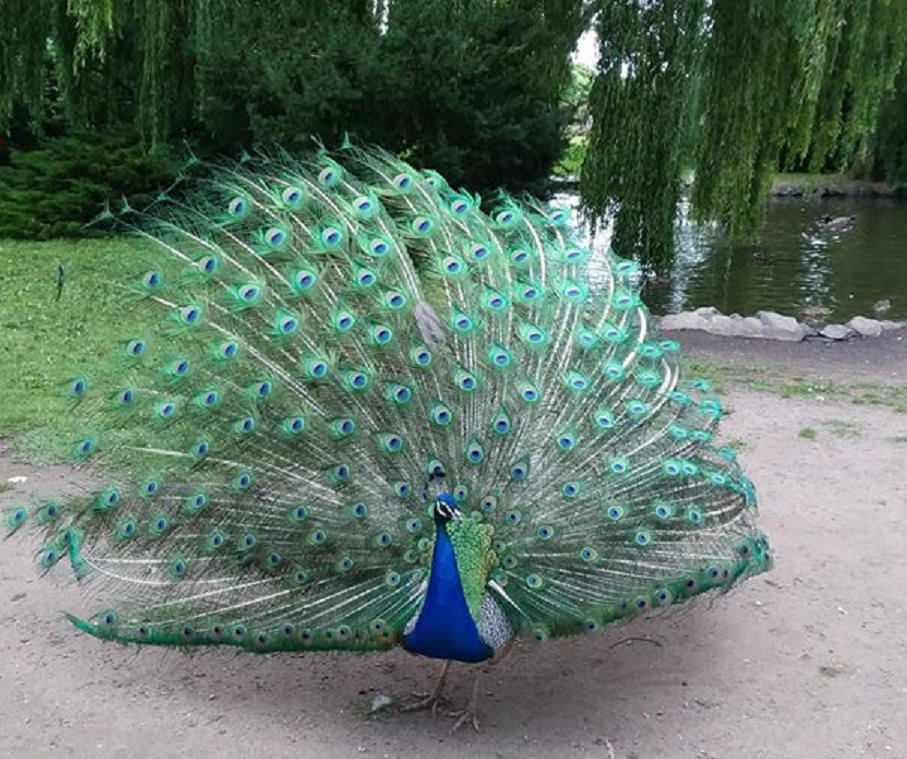 To use a spectacular example, let’s focus on peacocks. The most spectacular feature that peacocks have (the males are peacocks, the females are peahens) is their train of tail feathers. Peahens seem to prefer males who have trains with more eyespots. How do we know? In a study of peacock mating behavior led by Marion Petrie, the number of eyespots in a male’s train of feathers was positively correlated with male mating success.
To use a spectacular example, let’s focus on peacocks. The most spectacular feature that peacocks have (the males are peacocks, the females are peahens) is their train of tail feathers. Peahens seem to prefer males who have trains with more eyespots. How do we know? In a study of peacock mating behavior led by Marion Petrie, the number of eyespots in a male’s train of feathers was positively correlated with male mating success.
Let’s set some context. When it’s mating season for peacocks, here’s what happens. The description is from Sciencing peacock-features-8567066.
Beginning in mid to late spring, peacocks establish small territories in close proximity to one another in an arrangement known as a lek. They begin their courtship displays to attract the peahens, spreading their iridescent tail feathers in a fan shape, strutting back and forth, and shaking their feathers to produce a rattling noise to get the peahens’ attention. A peahen will walk through several territories of different males, examining their displays and feathers closely, before selecting a mate.
Petrie and her team observed peacock mating and quantified the results. Here’s an excerpt from Petrie’s 1991 paper.
On no occasion did a female mate with the first male that courted her and, on average, females visited three different males. Females thus always reject some potential mates. For 10 out of 11 sequences ending in successful copulation, the male ‘chosen’ at the end of a sequence had the highest eye-spot number among the males visited. These data support Darwin’s hypothesis that the peacock’s train has evolved, at least in part, as a result of a female preference.
On top of this, scientists have experimentally manipulated peacock trains. In one experiment, Petrie and her team removed eyespots from peacock trains. The result: “Peacocks with eye-spots removed showed a significant decline in mating success …compared with a control group.” (Behavioral Ecology and Sociobiology (1994) 34:212-217)
So think about what happens. Males and females become participants in a positive feedback system that results in the males’ extraordinary train of feathers. Females choose partners with longer tail feathers. The males who successfully mate pass on their genes for longer tail feathers, a trait that gets expressed in their male offspring. The females pass on their preference for longer male feathers, a trait that gets expressed in their female offspring.
How does this system begin in the first place? That is harder to explain. Choosy females are “looking” for evidence of fitness in their mates. A peacock who can produce a huge, brightly colored train of feathers must, from this perspective, be fit. But how does the process start? Earlier in this evolutionary process, any arbitrary difference that females start to find “attractive” might be selected for. Once the process begins, the positive feedback loop described above can lead to explosive evolutionary change.
Note that females are not only choosing physical traits but associated behaviors as well. Birdsong, courtship rituals, bower construction in bowerbirds, croaking in frogs, and firefly light patterns are behaviors that are all thought to be driven by intersexual selection.
7b. Intrasexual selection
In some mating systems, competition between males for control of a harem of females or control of a breeding territory is the main driver of sexual dimorphism. Competition between members of the same sex for access to the other sex is called intrasexual selection.
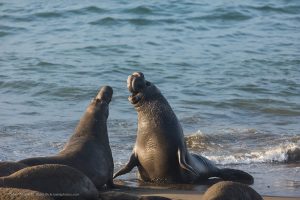
The Northern Elephant seal is an example of a species in which this system is at work. These animals live off the coast of California. Like all seals, they come on shore to breed.
Because breeding sites are limited, a male who can control a breeding area will have access to all of the females in that area. That sets off an evolutionary dynamic in which males compete for control of breeding beaches. Who wins in a competition like this? Usually the larger and more aggressive male.
As with intersexual selection, a positive feedback loop ensues. Among elephant seals, males can be up to 13 feet long, and weigh over 4000 pounds. Females grow to be 10 feet long, but are less than half the mass of the males, averaging about 1300 pounds.
7c. Sexual Selection: Checking Understanding
Again, sexual selection is a huge (and controversial) topic. Search for “sexual selection in humans” and you can go way down the rabbit hole. But for now, a quick check for understanding.
[qwiz qrecord_id=”sciencemusicvideosmeister1961-Sexual Selection, Checking Understanding”]
[h]Sexual selection
[i]
[q]Differences in form between the males and females of a species are called sexual [hangman].
[c]ZGltb3JwaGlzbQ==[Qq]
[q]Natural selection leads to [hangman]. Sexual selection leads to features that increase [hangman] success.
[c]YWRhcHRhdGlvbg==[Qq]
[c]cmVwcm9kdWN0aXZl[Qq]
[q]In [hangman] selection, members of one sex (typically females) choose whom they’ll mate with.
[c]aW50ZXJzZXh1YWw=[Qq]
[q]In [hangman] selection, members of one sex (typically males) compete with one another for reproductive access to the other sex.
[c]aW50cmFzZXh1YWw=[Qq]
[q]Male gorillas fight for control of a group of females. What kind of selection is at work?
[c]aW50ZXJzZXh1YWw=[Qq]
[c]aW50cmFz ZXh1YWw=[Qq]
[q]Male bowerbirds create highly decorated structures called bowers. Females examine these bowers. If they like them, they’ll mate with the male who made the bower. What kind of selection is at work?
[c]aW50ZXJzZXh1YW wgc2VsZWN0aW9u[Qq]
[c]aW50cmFzZXh1YWwgc2VsZWN0aW9u[Qq]
[q]The difference in form between the male and female Goldie’s bird of paradise probably arose through what kind of selection?
[c]aW50ZXJz ZXh1YWw=[Qq]
[c]aW50cmFzZXh1YWw=[Qq]
[q]These elk are battling for dominance. What kind of selection is at work?
[c]aW50ZXJzZXh1YWw=[Qq]
[c]aW50cmFz ZXh1YWw=[Qq]
[/qwiz]
Next move
- If you’re at the very start of the year (in the Biology Core Concepts) module, then this tutorial ends that module. Use the “Courses” menu above to move to another topic.
- If you’re in AP Bio, College Bio, or High School Bio, then proceed to Alleles in Gene Pools (the next tutorial in this module).
